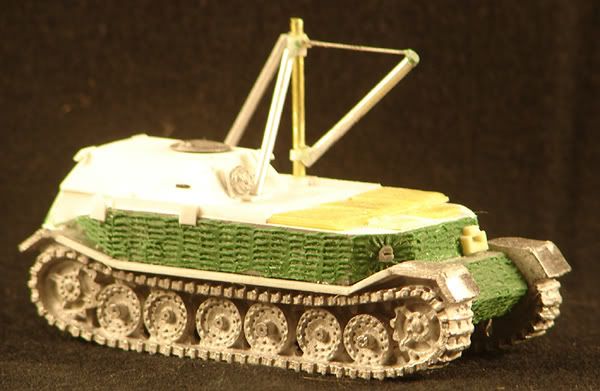First I want to apologize again for the lack of posts,
I've been continuing to work on my Black Brigade - they're now in the basing
stage. I've also been writing for a project that will be released later in the
year - I can't go into details yet, but watch this space for more information
in a few months. So without further ado - on to the post!
The Elefants and funnies of 653 Schwere Panzerjäger
Abteilung remain a popular (and fun to model) army for Flames of War. Building
some of the vehicles may seem daunting at first, but with a bit of patience
most modelers can successfully perform the conversions.
The key to any good conversion is starting with a good
set of plans. Plans for the Bergetiger (P) are available in several reference
books and online. The next step is to use imaging software to scale the drawings
to match the miniature. In this case you’ll want to use the Tiger (P) (GE076) miniature.
I typically use a set of digital or analog calipers to measure the key
dimensions on the drawing which will give me a scaling factor in the imaging
software. It is always best to use a longer measurement (like length) because
the impact of measurement error will be minimized. When scaling, it is also
best to scale all of the plans as one set of drawings rather than trying to
scale them as individual drawings.
With your scaled plans in hand, you can now begin to
actually convert the miniature. The Battlefront Tiger (P) miniature has the
very early fenders which don’t extend beyond the vehicle sides for most of the length
of the vehicle. To fix this, simply add some plastic card and sand it down to
create an even fender profile along the whole length of the miniature.
Unless you want to scratch-build a lot of the details on
the miniature, you’ll need to either borrow bits from other flames of war
miniatures or cast portions of other miniatures to use as templates. For the
Bergetiger (P) you’ll need the following details – From the Elefant (GE132) - Engine
decks, top hatches, side vision port, front vision port. From a Panzer IV Ausf G (GE044) – turret side
hatches. You’ll also need to borrow a Panzer
IV hull machine gun and a Hetzer (GE101) top machine gun.
Step 1 is sadly removing most of the detail from the existing miniature as all of the Bergetiger (P) ended up with zimmerit, and the Tiger (P) miniature is clean sided. I added zimmerit using green putty and a small flat-head screwdriver - well initially. I actually ran into an issue during construction and had to redo the zimmerit and did it the second time with Apoxie Scuplt (which seems to work better for zimmerit) using the same small flat-head screwdriver to create the pattern. Unfortunately I didn't get photos of the Apoxie Sculpt version before painting.
I covered the whole deck in 0.05" thick styrene and then built up the rear superstructure based on the plans I'd already scaled to the correct size. I modified a KV hatch (which was roughly the right size) to create the top hatch, but any appropriately sized circular hatch could be used. I then went through and added the various resin details (tow hooks, engine screens, hatches, vision blocks) back to the miniature.
There are several small details (crane blocks, a small raised fence around the superstructure, etc.) that I added with styrene which can be seen on the rear half of the miniature. I then moved on to final detailing The hardest part of the conversion (and the hardest to keep intact on the table) is the crane itself. I built it from a mix of brass rod, styrene rod, and wire. Unfortunately it remains fragile.
At that point I simply added the final details like the Hetzer machine gun, and painted it alongside the other miniatures. This particular miniature was painted before I started doing modulation, but it still holds up pretty well on the table. I'd hoped that Battlefront would include the option for the Bergetiger (P) in the 653 Schwere Panzerjäger Abteilung list in Fortress Italy, but instead the included the Bergepanther. That being said, I think it would be an allowable substitution which would more accurately reflect the unit on the table.




No comments:
Post a Comment